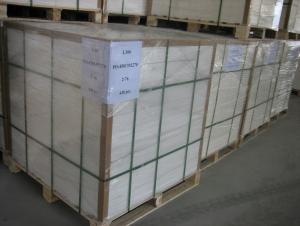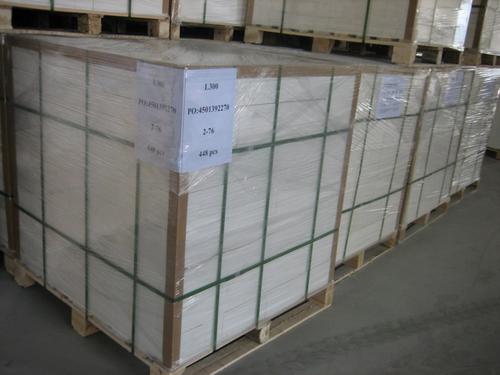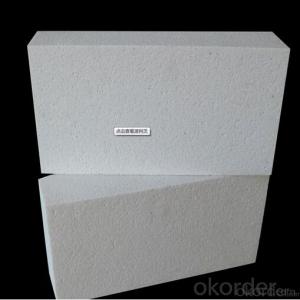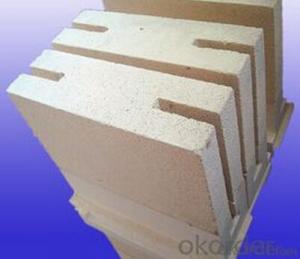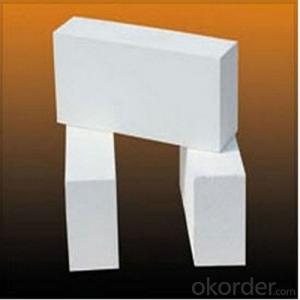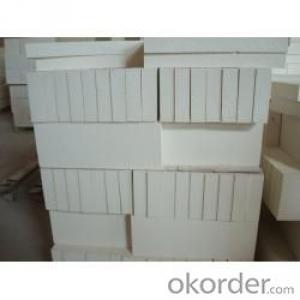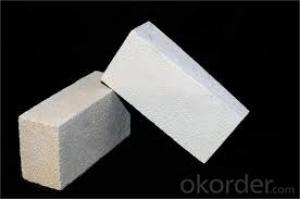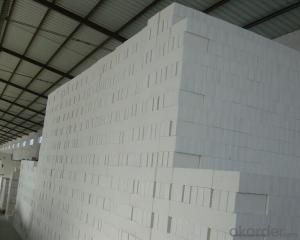GJM Series Insulating Fire Bricks
- Loading Port:
- Shanghai
- Payment Terms:
- TT OR LC
- Min Order Qty:
- 20 m.t.
- Supply Capability:
- 100000 m.t./month
OKorder Service Pledge
OKorder Financial Service
You Might Also Like
General Information
CMAX insulating firebricks are classified under temperature between 1300℃ to 1700℃, manufactured from high purity alumina clay.
1. Lower content of iron, alkaline and impurities, good high temperature properties.
2. Homogeneous structure, light weight, energy saving because lower heat storage in the furnace during cooling cycles.
3. High strength, good thermal shock resistance under high temperature.
4. Precise sizes due to grinding and shaping after sintering, which meets the requirement of construction.
5. Max service temp: Up to 1730C (3160F)
Feature
Light weight and low thermal conductivity
Low heat storage
Low iron and impurities
High thermal shock resistance
Application
CMAX insulating firebricks can be used as a hot face lining directly exposed to the heat or as a backup insulation layer in iron and steel mills, non-ferrous foundries, petrochemical, ceramic, glass.
ITEM | GJM30 | GJM28 | GJM26 | GJM23 |
Classification Temperature, ℉/℃ | 3000/1650 | 2800/1540 | 2600/1430 | 2300/1260 |
Bulk Density,g/cm³ | ≤1.0 | ≤0.9 | ≤0.8 | ≥0.5 |
Reheating Linear Change, % | ≤0.9 (1550℃,12 h) | ≤0.8 (1510℃,12 h) | ≤0.7 (1410℃,12 h) | ≤0.5 (1230℃,12 h) |
Al2O3 Content, % | ≥75 | ≥65 | ≥55 | ≥45 |
Fe2O3 Content, % | ≤0.5 | ≤0.6 | ≤0.7 | ≤1.0 |
Thermal Conductivity: | ||||
800℃, w/m.k | ≤0.39 | ≤0.37 | ≤0.35 | ≤0.18 |
1000℃, w/m.k | ≤0.43 | ≤0.41 | ≤0.39 | ≤0.20 |
1200℃, w/m.k | ≤0.48 | ≤0.46 | ≤0.43 | --- |
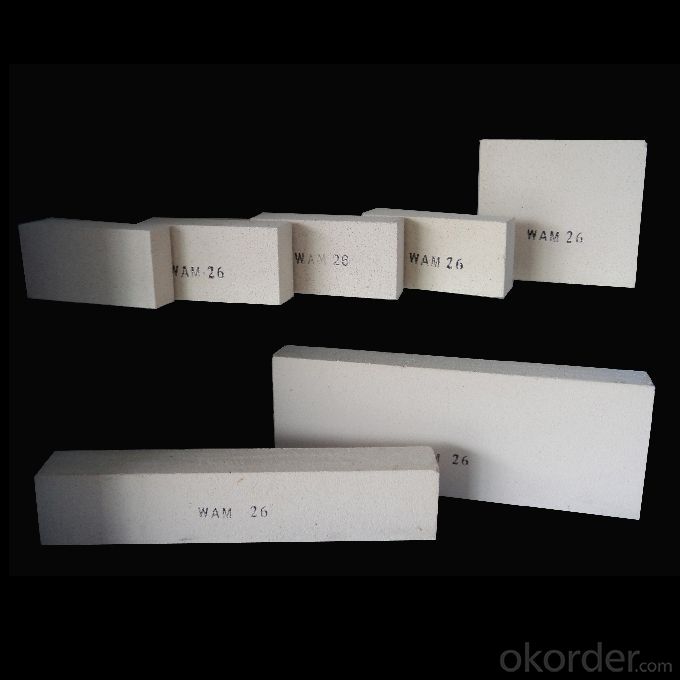
- Q: Are insulating fire bricks suitable for use in thermal shock applications?
- Yes, insulating fire bricks are suitable for use in thermal shock applications. Insulating fire bricks are designed to withstand rapid temperature changes without cracking or breaking. They have low thermal conductivity and high thermal resistance, which makes them an ideal choice for applications where thermal shock is a concern. These bricks are made from lightweight refractory materials, often containing a high percentage of alumina or silica, which gives them excellent thermal stability and resistance to thermal shock. They can be used in various high-temperature applications such as kilns, furnaces, and fireplaces, where they are exposed to extreme temperature fluctuations. Overall, insulating fire bricks are well-suited for thermal shock applications due to their ability to withstand rapid temperature changes and maintain their structural integrity.
- Q: Is it possible to paint or coat insulating fire bricks?
- Yes, it is possible to paint or coat insulating fire bricks. However, it is important to use a paint or coating that can withstand high temperatures, as insulating fire bricks are designed to be used in extremely hot environments. Regular paint or coatings may not be suitable as they can burn or deteriorate when exposed to high temperatures. It is recommended to use specialized high temperature paint or coatings that are specifically formulated to withstand the heat of insulating fire bricks. These paints or coatings typically have a high temperature resistance of several hundred degrees Celsius or more. Additionally, it is important to properly clean and prepare the surface of the bricks before applying any paint or coating to ensure good adhesion and durability.
- Q: Do insulating fire bricks require a protective coating?
- Insulating fire bricks do not necessarily require a protective coating, as they are already designed to withstand high temperatures and provide insulation. These bricks are made from lightweight refractory materials that have excellent thermal conductivity properties, allowing them to retain heat and prevent heat transfer. However, in some specific applications where the bricks may come into contact with corrosive materials or aggressive chemicals, a protective coating may be necessary to enhance their durability and resistance. Ultimately, the need for a protective coating depends on the specific usage and environment in which the insulating fire bricks are being used.
- Q: Can insulating fire bricks be used for insulation in power plants?
- Yes, insulating fire bricks can be used for insulation in power plants. Insulating fire bricks are designed to have excellent thermal insulation properties, which make them suitable for high-temperature applications. They can withstand extreme temperatures and provide effective insulation to prevent heat loss and increase energy efficiency in power plant operations. The insulating fire bricks are often used in various areas of power plants, such as furnaces, boilers, kilns, and chimneys. They can be used to line the walls, floors, and roofs of these structures to reduce heat transfer and maintain the desired temperatures inside the equipment. In power plants, insulating fire bricks help to minimize heat loss, improve combustion efficiency, and reduce thermal stress on the equipment. By providing a barrier against heat transfer, they help in conserving energy and reducing operational costs. Additionally, the insulation properties of these bricks also contribute to a safer working environment for power plant personnel. It's worth noting that while insulating fire bricks are suitable for insulation in power plants, they should be selected carefully based on the specific requirements and conditions of the power plant. Factors such as the operating temperature, chemical exposure, and mechanical stress should be considered to ensure the bricks can withstand the harsh conditions and provide long-lasting insulation performance.
- Q: Can insulating fire bricks be used as a base material for casting refractory shapes?
- Yes, insulating fire bricks can be used as a base material for casting refractory shapes. Insulating fire bricks are specifically designed to withstand high temperatures and provide insulation, making them suitable for use in refractory applications. These bricks have low thermal conductivity, which helps to minimize heat loss and maximize energy efficiency. Additionally, their lightweight nature makes them easy to handle and shape, making them an ideal base material for casting refractory shapes. However, it is important to consider the specific requirements and properties of the refractory shapes being cast to ensure that insulating fire bricks are the most suitable choice for the desired application.
- Q: Can insulating fire bricks be used in the construction of refractory coatings?
- Yes, insulating fire bricks can be used in the construction of refractory coatings. Insulating fire bricks are designed to have low thermal conductivity, making them suitable for insulating applications. When used as a component in refractory coatings, they can help to enhance the insulation properties and provide thermal protection.
- Q: Can insulating fire bricks be used in the construction of heat storage systems?
- Yes, insulating fire bricks can be used in the construction of heat storage systems. Insulating fire bricks are designed to have low thermal conductivity, which means they are capable of trapping and storing heat effectively. These bricks are made from materials such as fire clay, which have excellent insulation properties. By using insulating fire bricks, heat loss can be minimized, allowing for efficient heat storage and retention in heat storage systems. The bricks can be used to build the walls and lining of the heat storage system, ensuring that the stored heat is not dissipated to the surroundings. Additionally, insulating fire bricks are lightweight and easy to handle, making them a convenient choice for constructing heat storage systems. Overall, the use of insulating fire bricks in the construction of heat storage systems enhances their thermal efficiency and contributes to more effective heat management.
- Q: Can insulating fire bricks reduce heating or cooling costs?
- Yes, insulating fire bricks can help reduce heating or cooling costs. These bricks are specially designed to have a high level of thermal insulation, meaning they have low thermal conductivity and can effectively prevent heat transfer between the inside and outside of a building. When used in the construction of fireplaces, ovens, or kilns, insulating fire bricks can help retain heat within these structures, allowing them to reach and maintain higher temperatures with less energy consumption. This can lead to significant savings on heating costs, as less energy is required to achieve the desired temperature. Similarly, when used in the construction of walls, insulating fire bricks can help minimize heat transfer between the interior and exterior of a building. This can result in reduced heating or cooling needs, as the insulation helps to maintain a more stable indoor temperature. As a result, less energy is required to heat or cool the building, leading to lower energy bills and reduced overall heating or cooling costs. It is important to note that the effectiveness of insulating fire bricks in reducing heating or cooling costs can vary depending on various factors, such as the overall insulation of the building, the size and design of the structure, and the climate in which it is located. However, in general, using insulating fire bricks can contribute to energy efficiency and cost savings in heating or cooling systems.
- Q: Can insulating fire bricks be used in the construction of cremation chambers?
- Yes, insulating fire bricks can be used in the construction of cremation chambers. Insulating fire bricks are made from lightweight materials, such as vermiculite or perlite, which have excellent insulating properties. These properties make them suitable for high-temperature applications, such as cremation chambers, where they can help maintain a consistent and controlled temperature. Using insulating fire bricks in the construction of cremation chambers can provide several benefits. Firstly, they can help to improve energy efficiency by reducing heat loss. This can result in lower fuel consumption and cost savings. Secondly, the insulating properties of these bricks can help to maintain a stable temperature inside the cremation chamber, which is important for ensuring efficient and complete combustion of the deceased. Additionally, insulating fire bricks are lightweight and easy to handle, which can make the construction process more convenient and efficient. However, it is important to note that while insulating fire bricks can be used in the construction of cremation chambers, they are typically used in combination with refractory fire bricks. Refractory fire bricks are made from materials, such as clay or silica, that can withstand extremely high temperatures. These bricks are used in the areas of the cremation chamber that experience direct contact with the flames, while insulating fire bricks are used in the areas that require insulation. Overall, insulating fire bricks are a suitable choice for the construction of cremation chambers, as they provide excellent thermal insulation and can contribute to the efficient and controlled operation of the cremation process.
- Q: Is it possible to cut insulating fire bricks to fit custom shapes?
- Yes, it is possible to cut insulating fire bricks to fit custom shapes. Insulating fire bricks are made from lightweight materials such as ceramic fiber, which can be easily cut or shaped using various tools. Common methods for cutting insulating fire bricks include using a saw, knife, or even a hot wire cutter. It is important to follow proper safety precautions and wear protective gear when cutting these bricks, as the cutting process may produce dust or sharp edges. With the right tools and techniques, it is possible to cut insulating fire bricks to fit any desired custom shape.
Send your message to us
GJM Series Insulating Fire Bricks
- Loading Port:
- Shanghai
- Payment Terms:
- TT OR LC
- Min Order Qty:
- 20 m.t.
- Supply Capability:
- 100000 m.t./month
OKorder Service Pledge
OKorder Financial Service
Similar products
Hot products
Hot Searches
Related keywords
